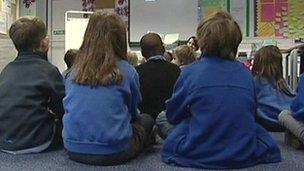Number of over-sized classes for infants doubles
- Published

Many local authorities have added "bulge" classrooms
The number of large infant classes in England has more than doubled in the past four years, government data shows.
By law, classes for infants have a limit of 30 children, although exceptions are allowed for various reasons.
Latest figures show there are just over 1,500 over-sized classes for this age this year, compared with 724 in 2008.
The figure is a small rise on last year, when there were about 1,370 such classes.
And it represents 2.7% of all the infant classes in England.
There is pressure on councils in England to find extra primary school places. Official forecasts earlier this year showed an extra 450,000 places would be needed in England by 2015.
Infant classes - reception, years one and two - are for children aged from four to seven.
In most cases, the over-sized classes have been legally expanded above the 30 pupil limit.
Schools are allowed to waive the limit when families move to an area mid-year and no other places can be found near them; if the parents have won a place after an appeal or if a child is admitted because of their special educational needs.
Recent changes also mean schools can do so to let in twins or children of members of the armed forces.
In nearly half of cases this year when an infant class was lawfully expanded, it was because of an appeal decision. The next most common reason was children being admitted outside the normal admission time.
Calls to drop limits
The <link> <caption>statistics </caption> <altText>statistics from Department for Education </altText> <url href="http://www.education.gov.uk/researchandstatistics/statistics/a00209478/dfe-schools-pupils-and-their-characteristics-january-2012" platform="highweb"/> </link> also show average class sizes and these are 27 children per class both in infant and junior classes in England's primary schools. In state-funded secondary schools, the average is 20.
Separate figures have shown there are many unfilled primary school places in England - more than 444,000 - either where parents are shunning unpopular schools or local child numbers are falling.
In Scotland, the average class size for infants is 22 - and 23 for primary classes overall.
Earlier this year, Sutton Council in London called on the government to lift the limit on infant class sizes, saying this would help deal with the shortage of primary school places.
London and Birmingham are among the areas facing the biggest shortages. More schools and classrooms are being built there and in other hot-spots across the country.
Labour set the legal limit on infant class sizes in 1998.
The shadow education secretary Stephen Twigg said: "We have seen that Michael Gove is going back to the future on exams - they are doing the same on class sizes.
"Under a Labour government, the numbers of pupils in infant classes larger than 30 fell dramatically - a key pledge in our 1997 manifesto."
The Department for Education said most classes with more than 30 pupils had been expanded lawfully, for sensible reasons.
A spokeswoman said: "The average class size at state-funded primary schools has increased by 0.1 percentage points, but the average class size in state-funded secondary schools has remained the same and the numbers of unlawfully large classes in infant schools has decreased dramatically".
"We are more than doubling targeted investment at areas facing the greatest pressure on numbers - to over £4 billion in the next four years.
"We are also building Free Schools and letting the most popular schools expand to meet demand from parents and we are intervening to drive up standards in weak primaries across the country which have thousands of empty places simply because parents don't want to send their children to them."
- Published5 January 2012
- Published14 February 2012
- Published10 January 2012
- Published28 January 2011
- Published7 December 2011
- Published11 October 2011
- Published26 May 2011
- Published27 October 2010
- Published3 November 2011